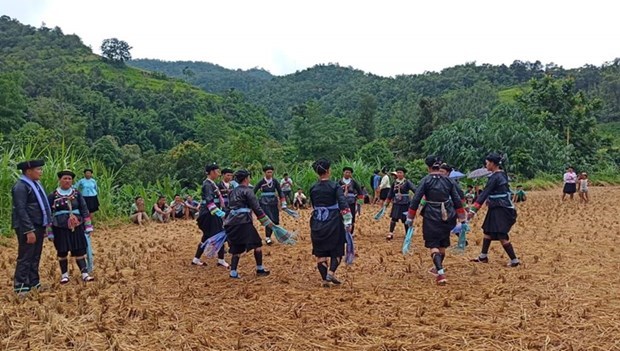Peace Praising Festival of Giay ethnic people in Ha Giang province
 Singing and dancing at the Peace Praising Festival of Giay ethnic people in Nam Ban commune, Meo Vac district, Ha Giang province (Source: Ha Giang newspaper)
Singing and dancing at the Peace Praising Festival of Giay ethnic people in Nam Ban commune, Meo Vac district, Ha Giang province (Source: Ha Giang newspaper)The Peace Praising Festival, one of the typical rituals of Giay ethnic people in Nam Ban commune, Meo Vac district, Ha Giang province, has been listed in the national intangible cultural heritage items.
Nam Ban commune is home to seven ethnic groups, namely the Giay, Mong, Tay, Cao Lan, Kinh, Dao and Pa Then cultural groups. Of which, Giay ethnic group makes up 72 percent, living close-knit in villages, hence, still preserving traditional cultural features, including Peace Praising Festival.
The Peace Praising Festival, which is also known as the Sword Dance Festival takes place during the traditional Lunar New Year festival in the northern mountainous province of Ha Giang. It aims to pray for bumper crops, peace and happiness.
According to Luc Thanh Minh, the shaman of the peace ritual, and the sword dancer Nong Thanh Cu, both from Nam Ban commune, the peace praising ceremony has been passed down for generations, and the offerings are recorded in the shamans’ ancient books. The origin of the worshiping ceremony is the spirit of martial arts, the urge to encourage the community to unite together, and the determination to protect villages and hamlets.
On the day of worship, families have their members to participate in the events. The Peace Praising Ceremony does not place much emphasis on the form as well as the offerings presented to the gods. Instead, it is simply symbolic to express the sincere desires of the worshippers. Upon the organization of the ritual, the village head will invite shamans and representatives of households to agree on the date, venue and contribution of each family. The ceremony usually takes place in the morning. It can take place in a harvested field or a large yard, sometimes even in a family's house. The village head is responsible for arranging people to prepare food and serve the participants.
During the ceremony, every family has members to join the event from the early morning. Those who do not participate directly are responsible for cooking rice and preparing offerings. The shamans and the dancing group, usually having 10-14 people, are required to wear traditional male costumes of the Giay ethnic people.
When everything is ready, all villagers join the worshipping ceremony. They pray for peace, health, luck, bumper crops, and good weather conditions.
After the main ceremony is over, villagers perform the sword dance, simulating the traditional martial arts of the Giay ethnic people in the past. Each performer uses props to simulate different types of weapons. The sword dance lasts for about 45 minutes. The shaman makes a long beat drum to mark the end of the dance. Dancers line up in a horizontal row in front of the altar. The shaman takes a bowl of water, using a twig of a tree to sprinkle the water on the dancers with the aim of cleansing and warding off evil spirits and bad luck.
After the sword dance, villagers sing traditional songs praising the gods and showing their gratitude to the ancestors. They later join a meal, which is held at a shaman’s, village head’s, or family’s house. Being selected as a post-ritual gathering is the honor of the host. The selected house must be spacious enough to welcome as many guests as possible.
The peace praising ritual of the Giay ethnic people is a humanitarian social custom that demonstrates respecting morale and a spiritual bridge between the universe and people. It also illustrates the determination of villagers to protect peace and strive for a better life./












